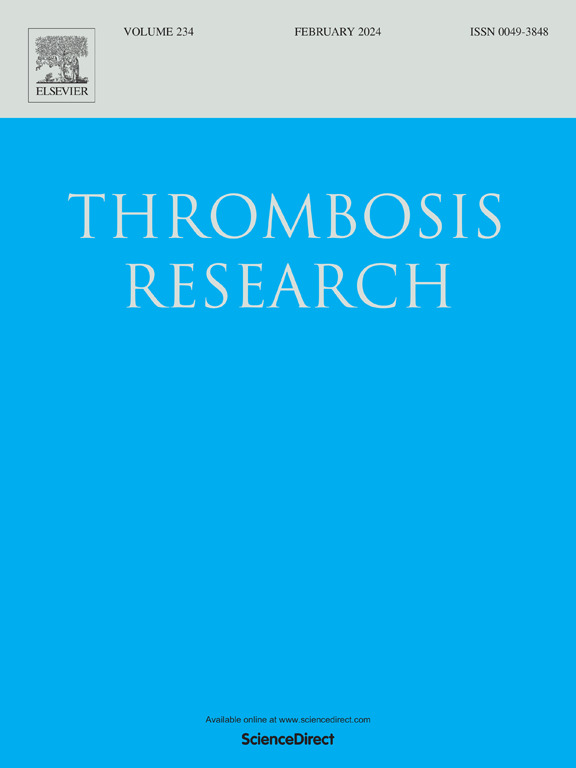1型糖原蓄积症患者的出血素质是否与原发性止血有关?
IF 3.4
3区 医学
Q1 HEMATOLOGY
引用次数: 0
摘要
目的糖原沉积病I型(GSD-I)是一种伴有出血倾向的代谢性疾病。虽然在这种情况下有血管性血友病因子(VWF)降低和/或血小板功能受损的报道,但未证实与出血有直接联系。本回顾性研究的目的是评估19例GSD-I患者原发性止血异常与出血素质之间的相关性。方法采用标准化国际血栓与止血学会出血评估工具(ISTH-BAT)评分,评估患者的出血史。观察血小板关闭时间、VWF活性、抗原水平及血小板聚集情况。结果19例患者中有7例(37%)年龄ISTH-BAT评分阳性。出血症状主要是皮肤粘膜。13例患者(76%)闭锁时间延长,ISTH-BAT阳性(ISTH-BATpos组)和阴性(ISTH-BATneg组)差异无统计学意义(p = 0.60)。ISTH-BATpos组的2例患者VWF水平有中度下降。然而,ISTH-BATpos组和ISTH-BATneg组在VWF活性(p = 0.40)和抗原(p = 0.82)水平上均无统计学差异。4例患者出现血小板聚集缺陷,主要与ADP激动剂有关,两组差异无统计学意义(p = 0.12)。结论正如预期的那样,gsd - 1与皮肤粘膜出血风险增加有关。然而,在本研究中未观察到原发性止血障碍与出血倾向之间的相关性。本文章由计算机程序翻译,如有差异,请以英文原文为准。
Is primary hemostasis involved in bleeding diathesis in patients with type 1 glycogen storage disease?
Objectives
Glycogen storage disease type I (GSD-I) is a metabolic disease associated with a bleeding tendency. Although decreased von Willebrand factor (VWF) and/or impaired platelet function have been reported in this condition, no direct link with bleeding has been demonstrated. The aim of this retrospective study was to assess the correlation between primary hemostasis abnormalities and haemorrhagic diathesis in a cohort of 19 GSD-I patients.
Methods
A Standardized International Society of Thrombosis and Hemostasis Bleeding Assessment Tool (ISTH-BAT) score was calculated for all patients to assess their bleeding history. Primary hemostasis was investigated by platelet closure time, VWF activity and antigen levels, and platelet aggregation.
Results
Seven of the 19 patients (37 %) had a positive ISTH-BAT score for age. Bleeding symptoms were essentially mucocutaneous. Thirteen patients (76 %) had a prolonged closure time with no significant difference whether ISTH-BAT was positive (ISTH-BATpos group) or negative (ISTH-BATneg group) (p = 0.60). Two patients in the ISTH-BATpos group had a moderate decrease in VWF levels. However, no statistical difference was observed between ISTH-BATpos and ISTH-BATneg groups regarding VWF activity (p = 0.40) or antigen (p = 0.82) levels either. Four patients had defective platelet aggregation, mainly in response to ADP agonist, with no significant difference between the two groups (p = 0.12).
Conclusion
As expected, GSD-I was found to be associated with an increased risk of mucocutaneous haemorrhage. However, no correlation was observed between primary hemostasis impairment and bleeding tendency in the present study.
求助全文
通过发布文献求助,成功后即可免费获取论文全文。
去求助
来源期刊

Thrombosis research
医学-外周血管病
CiteScore
14.60
自引率
4.00%
发文量
364
审稿时长
31 days
期刊介绍:
Thrombosis Research is an international journal dedicated to the swift dissemination of new information on thrombosis, hemostasis, and vascular biology, aimed at advancing both science and clinical care. The journal publishes peer-reviewed original research, reviews, editorials, opinions, and critiques, covering both basic and clinical studies. Priority is given to research that promises novel approaches in the diagnosis, therapy, prognosis, and prevention of thrombotic and hemorrhagic diseases.
 求助内容:
求助内容: 应助结果提醒方式:
应助结果提醒方式:


